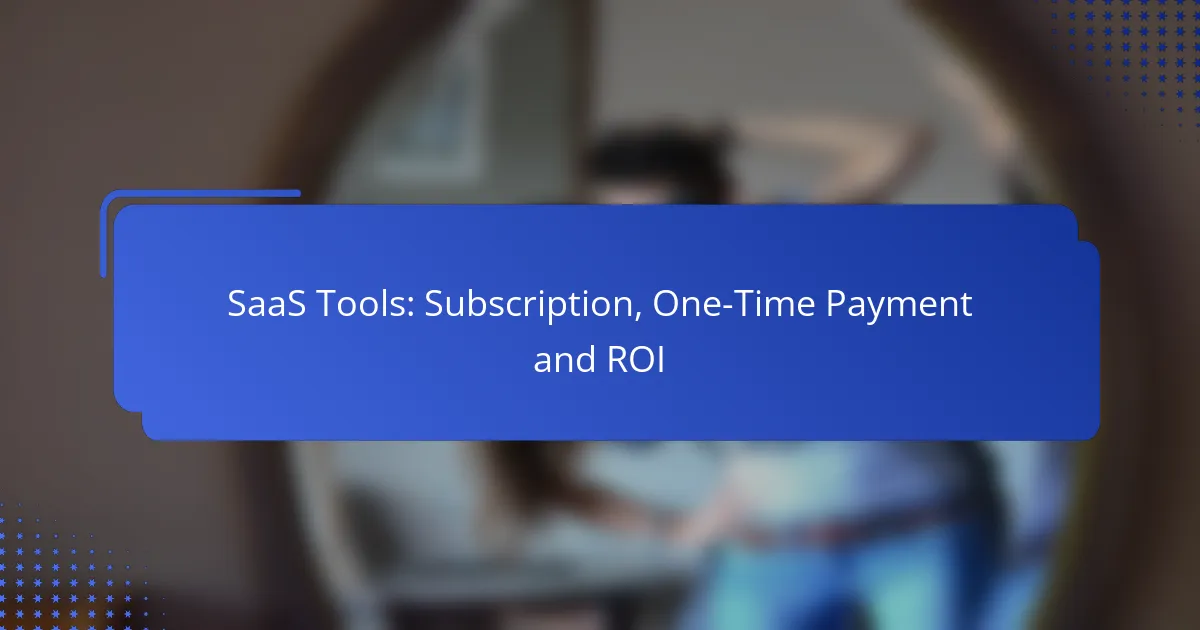SaaS tools have transformed the way businesses manage software expenses, offering various payment models such as subscription and one-time payment options. Subscription-based services provide predictable costs and continuous updates, while one-time payments appeal to those seeking to minimize ongoing expenses. Understanding the return on investment (ROI) from these tools is crucial for organizations to evaluate the financial benefits against their costs, ensuring informed decision-making in software investments.

What are the benefits of subscription-based SaaS tools in Canada?
Subscription-based SaaS tools offer Canadian businesses predictable costs, continuous updates, and flexibility to scale. This model allows companies to manage their software expenses more effectively while benefiting from ongoing support and enhancements.
Predictable budgeting
Subscription-based SaaS tools enable businesses to forecast their software expenses accurately. With fixed monthly or annual fees, companies can avoid unexpected costs associated with one-time purchases or upgrades. This predictability helps in aligning software spending with overall budget planning.
For example, a small business may subscribe to a project management tool for around CAD 20 to CAD 50 per user per month, allowing them to plan their finances without worrying about fluctuating costs.
Regular updates and support
One of the key advantages of subscription SaaS tools is the provision of regular updates and customer support. Subscribers receive the latest features and security enhancements automatically, ensuring they are always using the most current version of the software.
This continuous support can significantly reduce downtime and improve productivity, as businesses do not need to allocate resources for manual updates or troubleshooting. Many providers also offer dedicated support teams, enhancing the user experience.
Scalability for businesses
Subscription-based SaaS tools provide excellent scalability, allowing businesses to adjust their usage based on current needs. Companies can easily add or remove users and features as their requirements change, making it suitable for both small startups and larger enterprises.
For instance, a growing company can start with a basic plan and upgrade to a more comprehensive package as their team expands, ensuring they only pay for what they need at any given time. This flexibility is particularly beneficial in dynamic markets where business needs can shift rapidly.
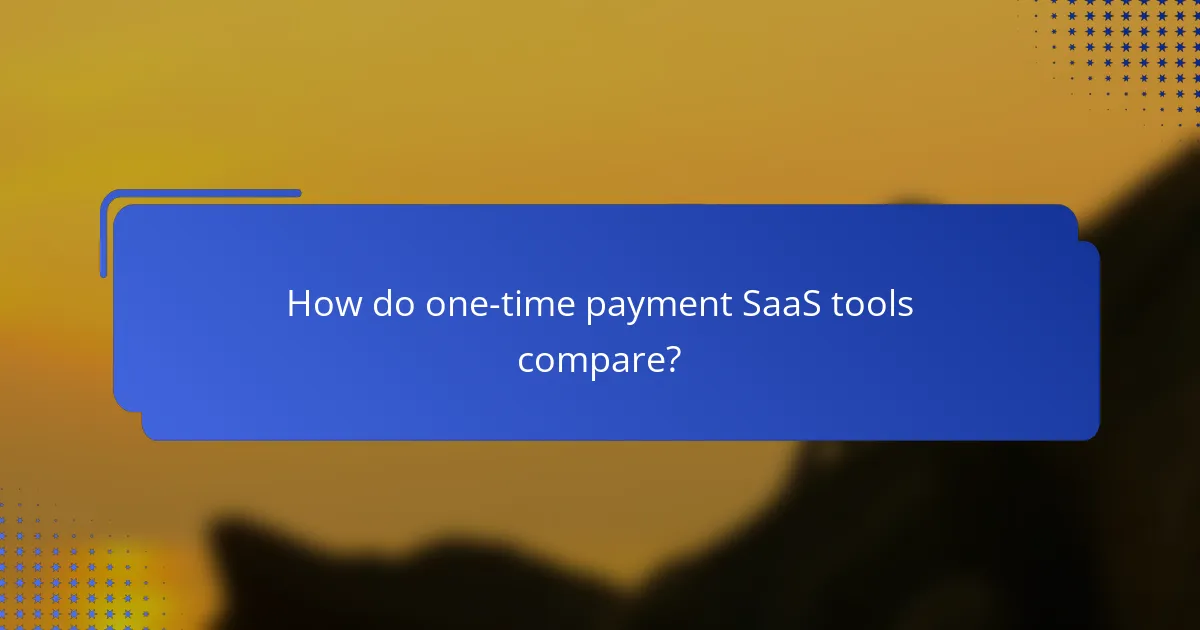
How do one-time payment SaaS tools compare?
One-time payment SaaS tools typically require a single upfront cost, contrasting with subscription models that charge recurring fees. This payment structure can be appealing for businesses looking to minimize ongoing expenses while ensuring they have access to essential software.
Lower upfront costs
One-time payment SaaS tools often have lower initial costs compared to subscription services, which can require substantial ongoing payments. This can be particularly beneficial for startups or small businesses with limited budgets. For example, a one-time payment of around $200 to $500 might cover the software for several years, whereas a subscription could cost $20 to $50 monthly.
Ownership of software
With one-time payment SaaS tools, users generally own the software outright after purchase. This ownership means that businesses can use the software indefinitely without worrying about subscription renewals or service interruptions. However, it’s essential to consider that ownership may come with limitations on updates and support.
Limited long-term support
One-time payment models often provide limited long-term support compared to subscription services, which typically include ongoing updates and customer service. Users may need to pay extra for significant updates or technical assistance. Businesses should evaluate their need for support and updates when choosing a one-time payment tool, as this could impact the software’s effectiveness over time.
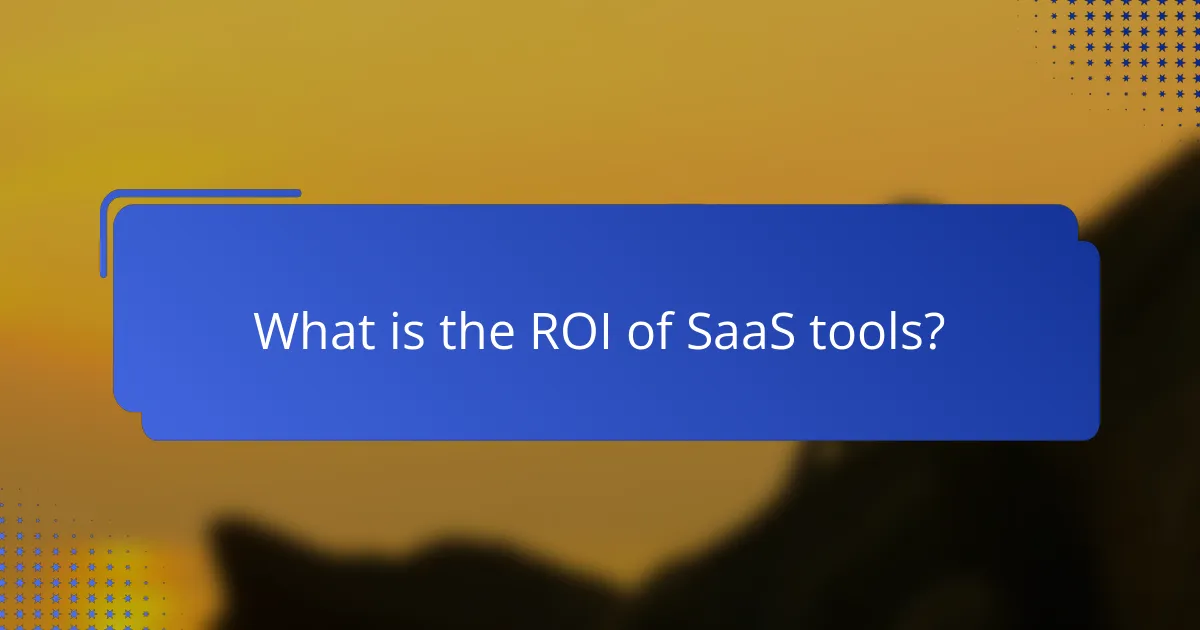
What is the ROI of SaaS tools?
The ROI of SaaS tools refers to the return on investment that businesses can expect from using software-as-a-service solutions. This metric evaluates the financial benefits gained from SaaS tools compared to their costs, helping organizations make informed decisions about their software investments.
Increased productivity
SaaS tools often enhance productivity by automating routine tasks and streamlining workflows. For example, project management software can reduce the time spent on tracking progress and managing deadlines, allowing teams to focus on high-value activities.
Additionally, many SaaS applications offer real-time updates and notifications, which help teams stay aligned and respond quickly to changes. This can lead to significant time savings, often translating to increased output without a proportional increase in effort.
Cost savings over time
Investing in SaaS tools can lead to substantial cost savings in the long run. Unlike traditional software that requires hefty upfront payments, SaaS typically operates on a subscription model, allowing businesses to spread costs over time. This can be particularly beneficial for small to medium-sized enterprises that may have limited budgets.
Moreover, SaaS solutions often include maintenance and updates in their pricing, eliminating unexpected expenses associated with software upkeep. Businesses can save on IT resources and infrastructure costs, as many SaaS tools are hosted in the cloud, reducing the need for on-premises hardware.
Enhanced collaboration
SaaS tools facilitate improved collaboration among team members, regardless of their physical location. Cloud-based applications enable multiple users to access and work on the same document or project simultaneously, fostering a more cohesive team environment.
Furthermore, many SaaS platforms integrate communication features, such as chat and video conferencing, which can enhance interaction and decision-making. This level of collaboration can lead to faster project completion and a more innovative work culture.
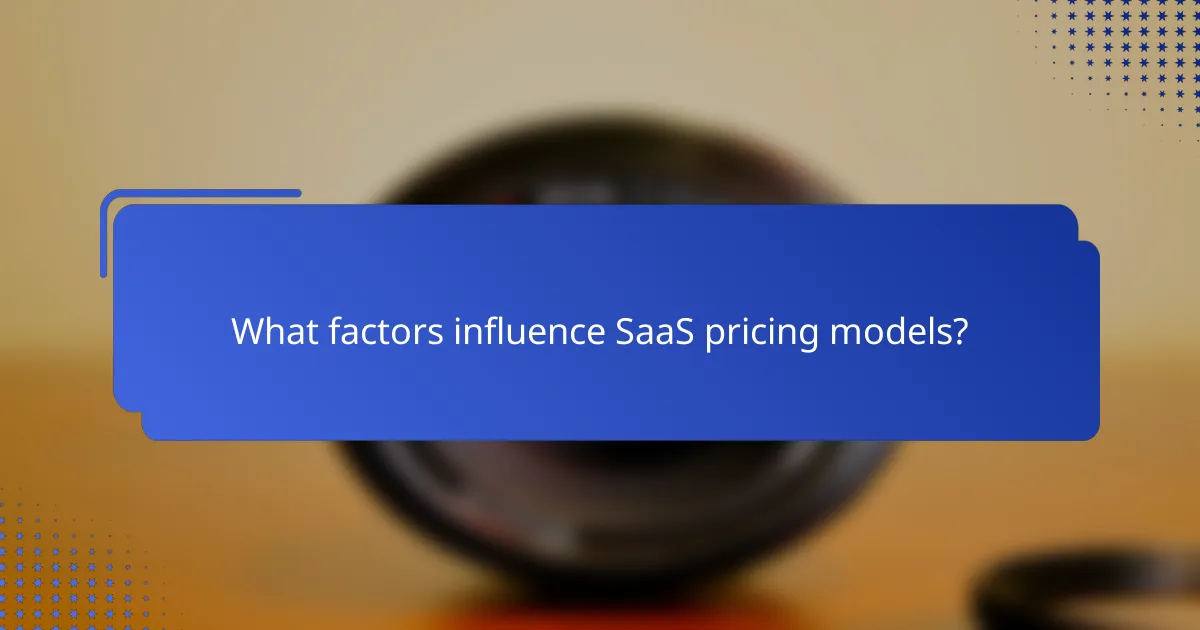
What factors influence SaaS pricing models?
SaaS pricing models are influenced by various factors including feature sets, market competition, and user base size. Understanding these elements can help businesses choose the right pricing strategy to maximize revenue and customer satisfaction.
Feature sets and capabilities
The features and capabilities offered by a SaaS product significantly impact its pricing model. More advanced functionalities, such as integrations, analytics, and customization options, often justify higher subscription costs. For example, a basic project management tool may charge around $10 per user per month, while a comprehensive solution with advanced reporting and collaboration tools could be priced at $30 or more.
When evaluating feature sets, consider the value they provide to users. A well-defined feature set that aligns with customer needs can lead to higher customer retention and willingness to pay.
Market competition
Market competition plays a crucial role in shaping SaaS pricing models. Companies must analyze competitors’ pricing strategies to remain competitive while ensuring profitability. If similar products are priced lower, businesses may need to adjust their pricing or enhance their offerings to justify a higher cost.
Conducting regular market research can help identify pricing trends and competitor offerings. This information allows companies to position their products effectively and adopt pricing models that attract customers without sacrificing margins.
User base size
The size of the user base can significantly affect pricing strategies for SaaS products. A larger user base often allows for lower per-user pricing due to economies of scale, while smaller companies may need to charge higher rates to cover costs. For instance, a SaaS provider with thousands of users might offer a subscription at $5 per user, while a niche provider with a limited audience may need to charge $15 or more.
When determining pricing based on user base size, consider tiered pricing models that cater to different customer segments. This approach can help maximize revenue while accommodating varying budgets and needs.
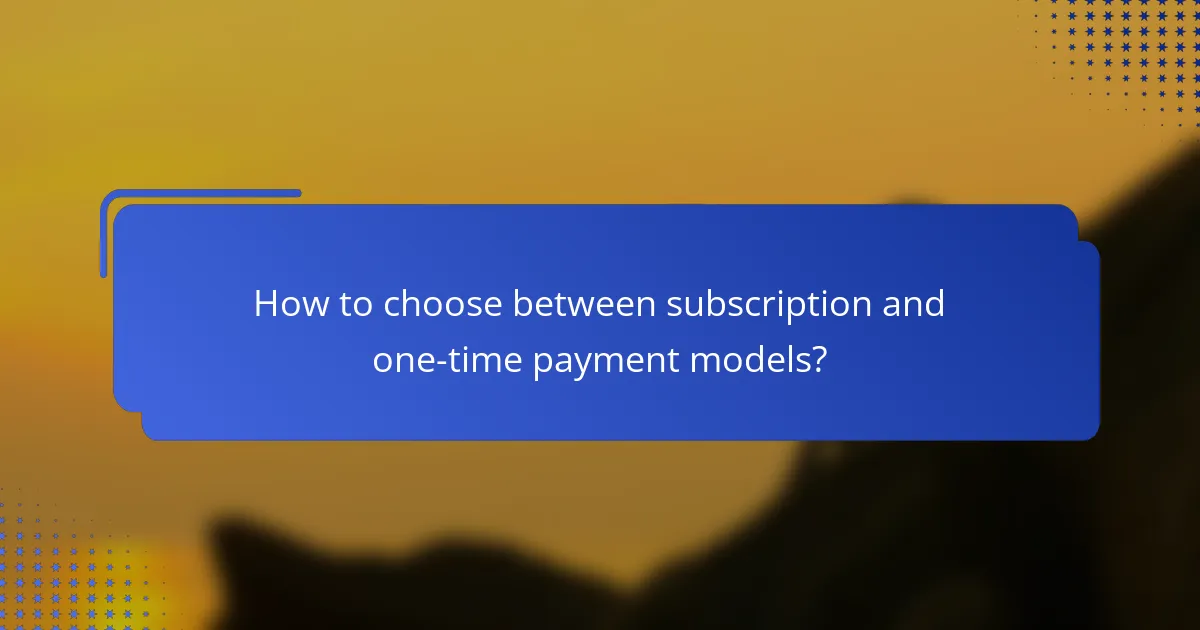
How to choose between subscription and one-time payment models?
Choosing between subscription and one-time payment models depends on your business needs, budget, and long-term goals. Each model has distinct advantages and trade-offs that can significantly impact cash flow and customer retention.
Business needs assessment
Start by evaluating your business requirements. If your software needs frequent updates and ongoing support, a subscription model may be more suitable, as it ensures continuous revenue and customer engagement. Conversely, if your product is stable and requires minimal updates, a one-time payment model could be more beneficial.
Consider the nature of your target audience. Businesses with fluctuating budgets may prefer subscriptions for predictable costs, while others may favor a one-time payment to avoid ongoing commitments.
Budget considerations
Your budget plays a crucial role in deciding between these payment models. Subscriptions typically require lower upfront costs, making them accessible for startups or small businesses. However, over time, the cumulative costs of subscriptions can exceed a one-time payment.
Analyze your cash flow. If you have the capital to invest upfront, a one-time payment might be more economical in the long run. On the other hand, if cash flow is tight, a subscription can spread costs over time, allowing for better financial management.
Long-term goals
Align your payment model choice with your long-term business objectives. If you aim for steady growth and customer retention, a subscription model can foster ongoing relationships and predictable revenue streams. This model often leads to higher customer lifetime value.
In contrast, if your goal is to maximize immediate revenue or if you plan to sell the software outright, a one-time payment model may be more appropriate. Evaluate how each model supports your strategic vision and operational needs.
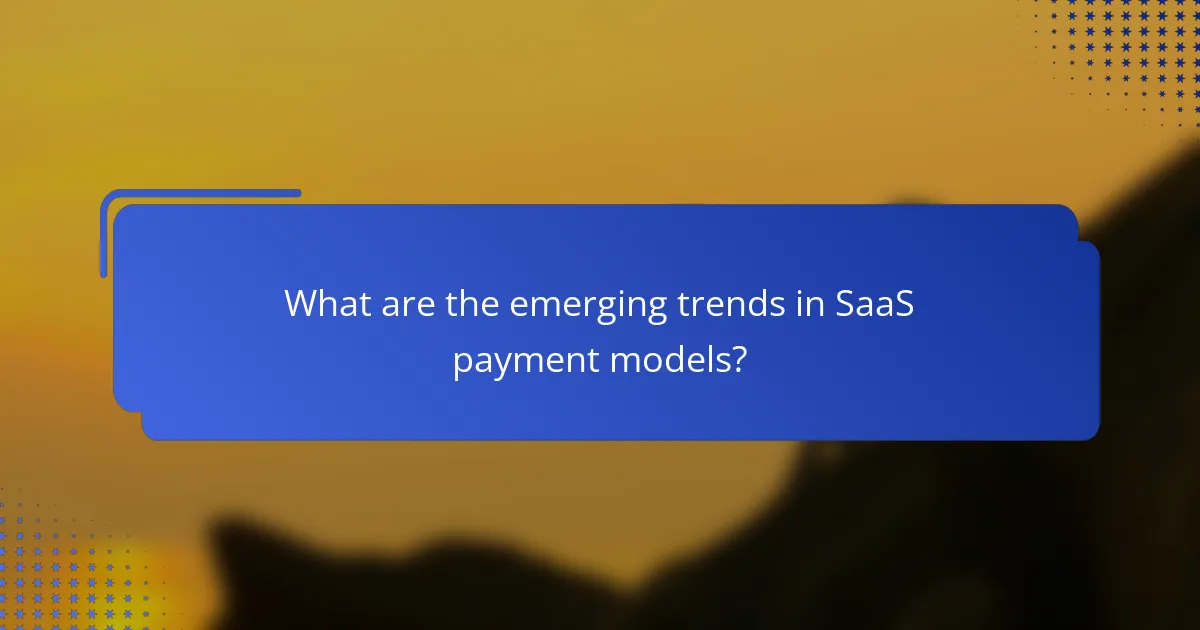
What are the emerging trends in SaaS payment models?
Emerging trends in SaaS payment models include a shift towards flexible subscription plans, usage-based pricing, and hybrid models that combine one-time payments with ongoing fees. These trends reflect the growing demand for adaptability and cost efficiency among businesses and consumers.
Subscription-Based Models
Subscription-based models are becoming increasingly popular, allowing users to pay a recurring fee for access to software. This approach provides predictable revenue for companies and lower upfront costs for customers, making it easier to budget for software expenses.
Common subscription structures include monthly and annual plans, often with tiered pricing based on features or usage levels. For example, a basic plan might start at around $10 per month, while premium tiers could exceed $100, depending on the services offered.
One-Time Payment Options
One-time payment options allow customers to purchase software outright, providing them with permanent access without ongoing fees. This model can be appealing for businesses that prefer to avoid recurring charges and want to own their software outright.
However, one-time payments often come with trade-offs, such as limited updates or support. For instance, a software package might cost $500 upfront but may require additional fees for major updates or technical support in the future.
Usage-Based Pricing
Usage-based pricing models charge customers based on their actual usage of the software, making it a flexible option for businesses with fluctuating needs. This model aligns costs with value received, allowing companies to scale their expenses according to their usage levels.
For example, a cloud storage service might charge $0.10 per GB stored, which can be more economical for businesses that do not require constant high storage levels. This pricing strategy can lead to significant savings for users who manage their usage effectively.
Hybrid Models
Hybrid models combine elements of subscription and one-time payment structures, offering a versatile approach to software pricing. These models might include an initial one-time fee followed by a subscription for ongoing support or updates.
For instance, a software product could be purchased for $300 upfront, with an annual subscription fee of $50 for updates and support. This model provides customers with the benefits of ownership while ensuring they receive ongoing enhancements and assistance.
